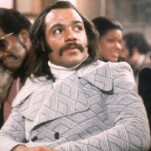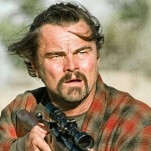Violence begets violence in Assault On Precinct 13, as the father of the slain girl guns down her killer, and then flees to a precinct in slummy Anderson, California, that’s in the process of being shut down (hence few weapons or staffers), and under the command of newly assigned Lieutenant Bishop (Austin Stoker). Complicating matters further, a trio of convicts, on its way to another prison, has made a pit stop at Precinct 13. They’re led by Napoleon Wilson (Darwin Joston), a cocky, wisecracking criminal whose recurring requests for cigarettes and refusal to explain the origins of his first name provide a strain of smart-ass humor.
Carpenter’s script lays out these events, as well as the trusting rapport between black Bishop and white office staffer Leigh (Laurie Zimmer)—who soon comes to share unspoken but palpable chemistry with Wilson—with great economy. Assault On Precinct 13’s shootouts boast a swift, gripping brutality, despite the fact that the swarming Street Thunder members who lay siege to the station exhibit an idiotic penchant for barreling headfirst through doorways and windows, thus making them easy targets.
Tension is amplified by the social and racial undercurrents that course throughout the film. Be it Bishop and Leigh’s early back-and-forth about a cup of coffee, the interracial makeup of Street Thunder (made up of whites, blacks, and Latinos), or the uneasy alliance between Bishop and Wilson, Assault On Precinct 13 steeps its action in a volatile multicultural stew. That mix is made even more explosive by the gender/sex issue of Leigh’s participation in the precinct’s defense—a thread that’s amusingly dramatized by her defusing a convict’s panic by grabbing the barrel of his gun and finding it unloaded.
As incisive as it is thrilling, Carpenter’s film is also gorgeous, courtesy of the director’s renowned use of the widescreen frame. From an early shot that foregrounds the headlamp of the Street Thunder members’ car during a chase, to the final image of Bishop and Wilson walking shoulder to shoulder, Carpenter’s imagery is a thing of propulsive beauty that both enhances suspense and expresses his characters’ ever-changing relations to one another. It’s a fleet, ferocious piece of genre craftsmanship.









































